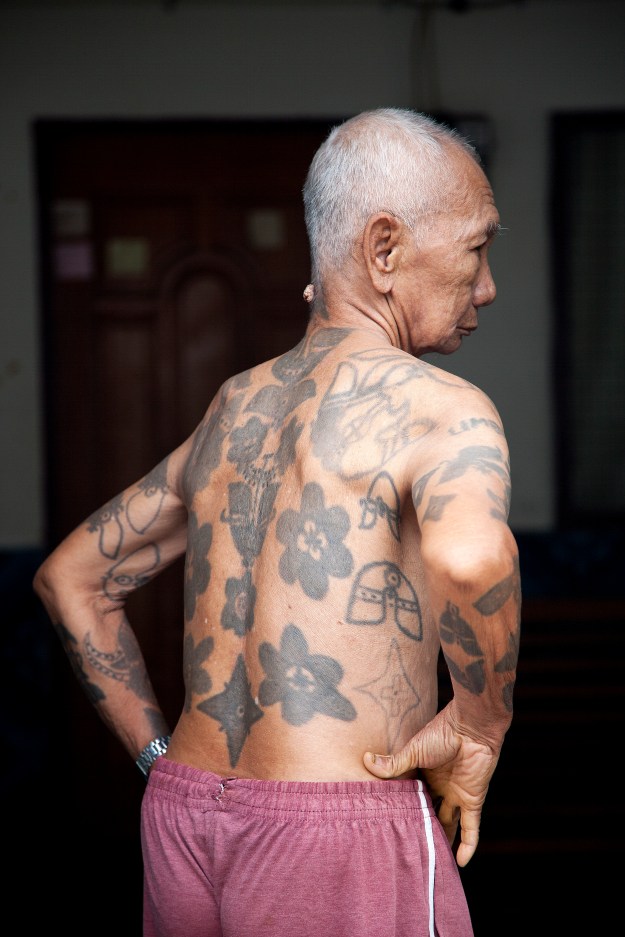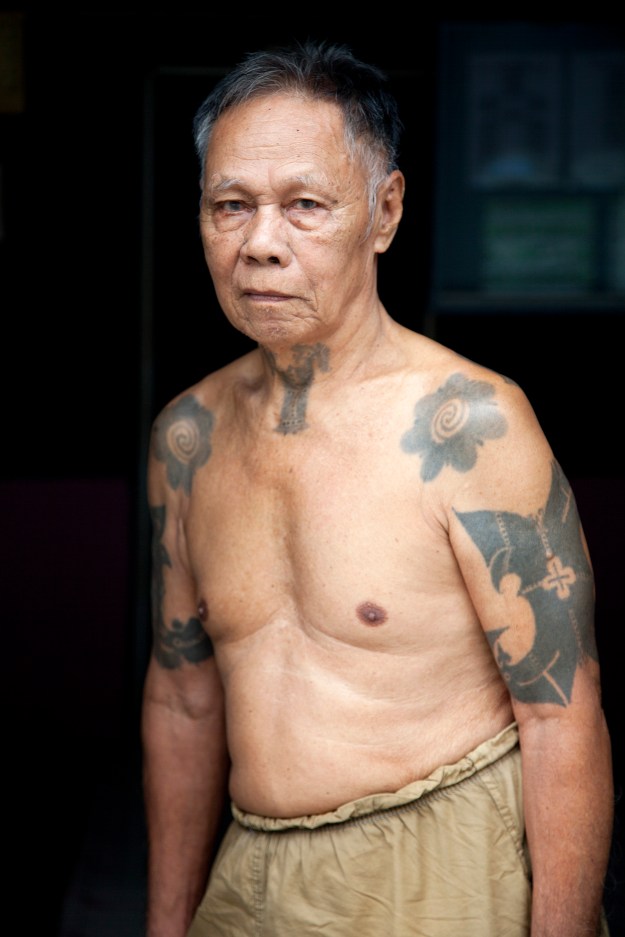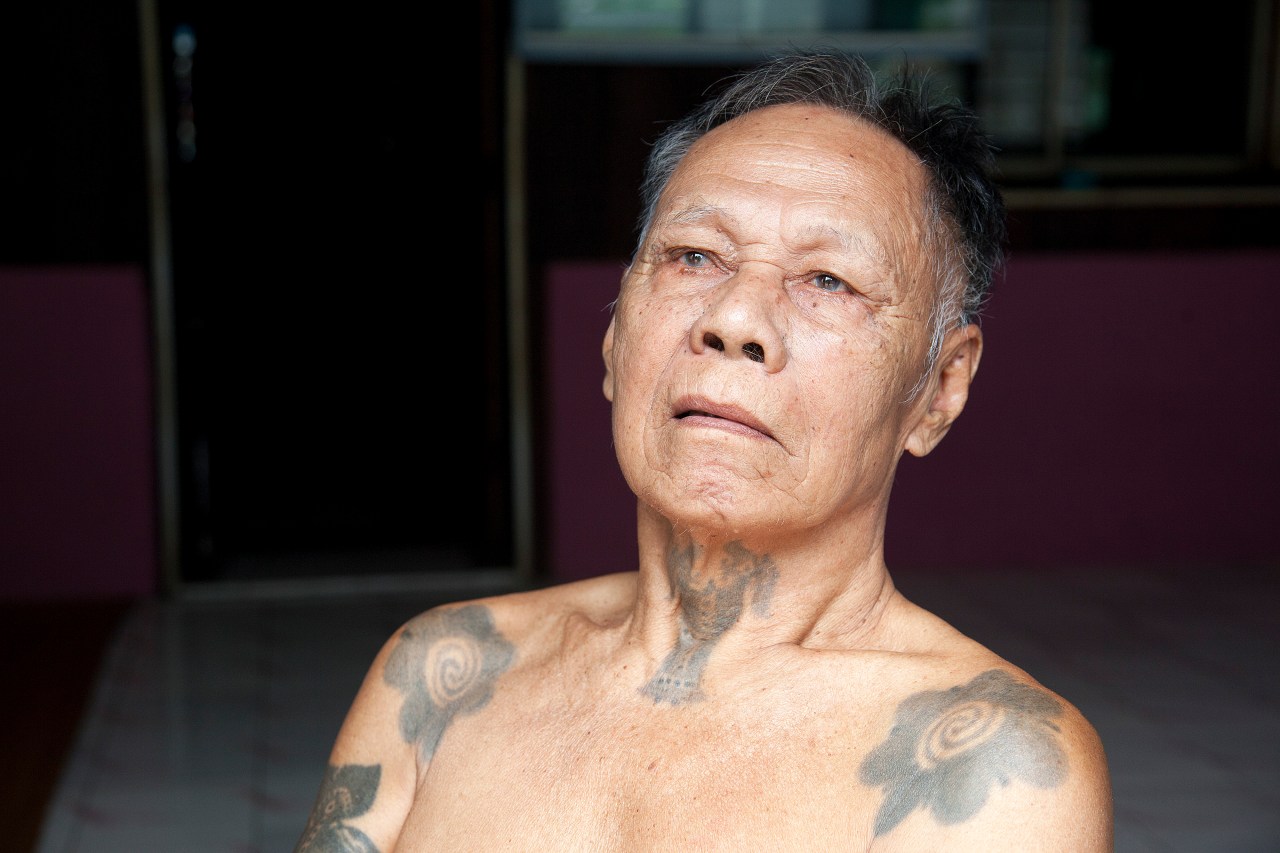Ernesto Kalum, the first professional modern tattoo artist in the state of Sarawak, keeps a studio in the local capital of Kuching. Occupying the second story of a colonial-era house close to the city’s waterfront promenade, it’s an airy space with burgundy walls covered in tattoo designs and artifacts he’s picked up during his travels through the region’s jungles. A matching red parlor chair and tattoo machine sit at the front of the shop, right under a pair of tall, arched stained glass windows. But Kalum almost never holds that tattoo gun.
You’re more likely to find him with his apprentice, Robin Unau Gaong, sitting cross-legged on cushions in the back, leaning over an individual lying on a mat between them. Unau stretches the person’s skin between his gloved hands while Kalum holds a stick studded with at least one ink-soaked needle over the area with one hand and pounds it into the flesh with the stick in his other hand. Usually, the studio is quiet, save for the rapid tap-tap-tap of Kalum hammering on his client. Sometimes he hums—maybe some Led Zeppelin, maybe some Milli Vanilli.
This is how Kalum practices pantang Iban, the tradition of hand-tap tattooing of his tribe, the Iban of Borneo. Thick, quasi-abstract, and symbolically dense patterns based on the plants and animals of the Bornean jungles, sometimes fused together and often decorated with rosettes and flourishes, these tattoos may be the best-known aspect of Iban culture—save for headhunting—in the wider world. Yet not just Iban but all of Borneo’s tattooing traditions nearly died out at the end of the last century. Since the millennium, Kalum and a few others have launched a successful revival of the Iban tradition in urban Sarawak. Together, they pulled a vital part of their heritage back from the brink and created a powerful symbol of indigenous identity. However, these tattooists are the first to admit that their iteration of the tradition is quite different from the Iban tattooing performed in the old days in their rural longhouses.


Hand tapping, historically done with bamboo sticks and needles in Borneo, is common across the Indonesian archipelago and the South Pacific. Tattoo anthropologist Lars Krutak, one of the few academic experts on this region’s ink traditions, suspects many Dayak—the blanket term for the island’s indigenous peoples—tribes borrowed designs from the island’s nomadic peoples, of whom only a few hundred Penan remain in the most remote and dense forest. It remains unclear how it originated amongst the Penan.
But Kalum’s tribe, the Iban—which are the largest Dayak group—believe tattooing came from the spirits; forces that live on a parallel plane of existence and occasionally cross into the human realm. According to one story, a man named Gendup met a girl while hunting and accepted an invitation to follow her back to her community’s longhouse. Inside, he met an elder covered in tattoos. The elder explained the tradition and convinced Gendup to let them tattoo him, proceeding to do so for three solid days. Only after he’d healed did his host inform him that he was Selang Pantang of the Antu Pantang, the Tattoo Spirits, and enjoined Gendup to take this tradition back to his people. This story, or some close variation on it, is common across a number of tribes today.
Every Dayak tribe had its own unique tattooing traditions. The Iban, for instance, put the bungai terung—stylized Bornean eggplant flowers with whirls in the center modeled after a pattern on the underside of a tadpole—on a young man’s shoulders just before he begins his bejalai, a wandering journey to acquire knowledge, wealth, and prestige. Throughout their lives, Iban men and women acquired tattoos as they achieved goals or reached new stages in life—including hornbills, messengers of war and harbingers of leadership, and crabs, dragons, and scorpions, powerful protectors.
The Iban tattooists were always men, who worked with spirit guides to combine and stylize the right symbols to match an individual and his or her achievement. Among their most well-known tattoos are the entegulun, geometric patterns on the hands of successful headhunters, and the rekong, a throat tattoo to protect accomplished men against headhunters. The Iban often spiked their ink, made of whatever natural pigments were at hand, with ground charms, like animal bones, for added magical potency.

The Kayan, a much smaller tribe, likewise gave people ink based on their accomplishments, often using similar placements and patterns to their Iban neighbors. But according to Krutak, two specific deities guided them: Bua Kalung, who worked with the upper class of society, and her daughter, Lahay Bua, who worked with the lower class. Female tattooists, who enhanced their work’s powers through sacrifices, always did their culture’s tattoos. They were especially well known for the snakelike bands of tattoos they drew on women’s legs.
No matter the tradition, though, Dayak tattoos acted as visual cues for an individual telling his or her life’s story. “When a person comes back from their bajelai,” says Kalum, “they use their tattoos as a reference of what they’ve been through.”
Almost everyone got tattoos, and as many as they could—their ability to acquire status and build a family depended on these proofs of accomplishment.
“In the old days, if you don’t have tattoos, you are nobody. You are a zero. You are considered naked, invisible,” says Kalum. “Our tattoos are like the clothes of our soul.”
Tattoos didn’t just reflect events in a person’s life though; Kalum described the process of tattooing as “very equivalent to a re-birth.” Many tribes had ritualistic spaces for tattooing, and sometimes wore special clothes similar to death shrouds. Many Dayak also believed that after they died, their tattoos would become lights to guide them across the River of Death. Those who took a misstep fell into the river, where they were consumed by a giant catfish.
This tattooing culture continued in most Dayak communities until the end of World War II, when a massive increase in both Western developers and missionaries infiltrated the Bornean jungle. The Christians and urbanites convinced many Dayak that their tattoos were shameful; only one of many ways they ripped up the foundations of their societies. Bereft of their old role in Dayak culture, tattoos faded quickly as the dominant forces of the late 20th century spread into the heartland.

Some communities, including the Iban and Kayan, held onto their tattooing traditions a bit longer than others, adjusting them with the times. The Iban incorporated work on Bruneian oil rigs or in urbanized seaports into their bejalai. But eventually, overwhelming cultural attrition and harsh laws banning those with tattoos from government service in Indonesia and Malaysia took their toll. Some even used acid to burn off their tattoos in order to find work with the state and forbid their children from getting tattooed.
“My father’s generation was the first that was formally educated—in the modern sense,” says Kalum, “so [he] has zero tattoos because of mission school and all the things like that… People [like him] wanted new things. They didn’t want to be regarded as primitive. People in the cities would look down on you because you wore a loin cloth or had a tattoo or something like that… From the 1980s towards the 90s, I never saw people practicing tattooing” in that old tradition.
The next generation pushed back against emerging modern norms. But they did so through Western counterculture—bikes, drugs, and rock and roll. As in the West, that culture came hand-in-hand with an interest in tattooing, especially in the 1990s and early 2000s. But although people like Kalum saw traditional tattoos on their grandparents, they opted for Western tattoos—even neo-tribal designs—instead of their own culture’s.
“You got to see it all the time,” Kalum reflects on Iban culture, “so you didn’t value it as much.”
Lacking a modern western tattooing scene in Sarawak, Kalum gave himself his first tattoo in 1993—a little Superman crest on his calf. He says he felt a kinship with the Kryptonian hero—that he too was a strong person, but that touching his homeland, where Dayak culture was fading, made him weak. After practicing on himself, he started tattooing others, using a machine jerry-rigged out of a Walkman motor, bits of pens and umbrellas, and rubber bands, in exchange for cigs and langkau, the local rice moonshine, while working on custom motorcycles.
You come from a tattooing culture. You have your two sticks to use.
Like many other young men trying to figure out where they fit in the new Borneo, Kalum wandered for a while, working on a Singaporean ship before studying law in the United Kingdom. At one point he happened upon a local tattoo shop where he noticed an Iban scorpion design on the wall, and learned the owner’s father had developed an appreciation for Iban tattooing while serving in Borneo during World War II—but this didn’t affect him much. He was still obsessed with Japanese sleeve, neo-tribal, and fantasy tattoos.
After graduating, Kalum returned to Sarawak in 1998 and decided to give tattooing a shot, using his homemade machine and hawking modern fantasy-inspired designs. But few were interested, even in modern tattoos, and he only got one or two commissions a week, forcing him to close the shop shortly after opening it. He returned to the Wolverhampton studio he’d visited during college bluffing his way into an apprenticeship.
And he would have probably stayed there, if not for a series of events which pushed him to reexamine his culture’s tattooing tradition. Kalum was not the only Iban man to undergo a journey like this, finding modern tattooing abroad and then exploring his own heritage. But he was arguably the key wellspring of the most intensely academic and obsessively authentic element of Sarawak’s Iban tattooing revival.
For fun and practice, Kalum experimented with Iban designs during his apprenticeship. In late 1999, he brought five of his fantasy and five Iban designs each to the first major tattoo convention that would accept him, in Lausanne, Switzerland. There, internationally renowned tattooists, press, and attendees took an interest in him. To his surprise, he was asked again and again for Iban machine tattoos.
“In my heart, I hoped they would ask for more of the fantasy-based things,” said Kalum.
While in Lausanne, Kalum got a guest spot at the city’s Ethno Tattoo studio, where one day the local tattooing master Felix Leu saw him doing text work on a woman’s stomach. He walked over, picked up Kalum’s machine, and told him, “this belongs in the trash.” Soon after, Kalum returned to Kuching.
“When I came back to Kuching, I reprocessed that,” says Kalum. “And I realized he meant: You come from a tattooing culture. You have your two sticks to use. Why do you need something mechanical like this to do what your people have been doing for thousands of years?”
Leu’s admonition sank in, as did the respect foreign tattooists had for his tribe’s tradition. So Kalum resolved to travel throughout the interior of Sarawak, visiting the most remote Iban longhouse, to learn from old men who remembered the faded tattooing culture. Some of those he approached in public shied away. One man with a throat tattoo hidden under a shirt collar tugged it up further when asked about it; another with headhunter tattoos fled when questioned. But hospitality regularly got him invited into rural longhouses where he could gently build trust and coax conversations to tattoo.
Slowly, he learned the symbolism, as well as the traditional techniques, of Iban tattooing.
In 2000, Kalum returned to Lausanne, where a client volunteered to let him try a traditional hand-tapped tattoo on him—a 15-hour, adrenaline-filled process. Then suddenly Leu’s son appeared and requested a traditional throat tattoo. Kalum obliged the following Sunday in front of a crowd of European tattoo enthusiasts and artist heavies. Within weeks, his reputation spread by word of mouth and he found himself booked solid for a year straight.
“Without my culture, I’m nothing,” Kalum says he realized. “I would be just like any other tattoo artist… It’s [also] where we come from. So if we don’t value it, then we don’t value ourselves.”

During the 2000s, Kalum and other Iban tattooists who made their own journeys of rediscovery, like Eddie David in peninsular Malaysia or Herpianto Hendra in Indonesia, opened studios, and racked up awards and media recognition, bolstering the image of traditional tattooing and the region’s wider tattooing culture. Today a young tattooist at Kuching’s Pengayau Ink studio who goes by the name Boy Iban estimates that 70 to 80 percent of Iban in the city wear at least one traditional design.
It’s not clear if the Iban revival will spread to other indigenous groups because their tattooing traditions weren’t as well recorded, old practitioners have died, and cultural memories have faded. Two Muruts, a Sabahan Dayak group, recently approached Krutak, the tattoo anthropologist, for help with their own revival. “I sent them some sources,” he says, but they’re just “very obscure journal articles from days long past” containing a few pictures and little context—which is more than exists for many tribes.
But many Dayak now wear Iban tattoos as a symbol of a broad indigenous identity. Young Iban usually get traditional tattoos as a sign of ethnic pride as well. “The world keeps on changing,” says Pairin Mingel of Kuching’s Skrang tattoo studio, “but people want to keep that little part of Iban on them.”
Tattoos are more easily integrated into modern life than many Iban cultural hallmarks, like living in a longhouse. But their meaning, as well as the rigor and ritual around them, has changed significantly in the modern era for many tattooists.
Many revival tattooists haven’t studied the history as extensively as Kalum. Boy Iban, a Kuching native, says he learned about Iban tattoos from Google, while Mingel got his education from old photos. Many, recognizing they operate outside of old contexts, feel free to use designs more as templates for modern cultural art. Some prefer machines to sticks because they offer harder lines, solid colors, less bleed. Mingel obeys a few rules on symbols placement, but others like Boy Iban will put any design anywhere and fuses them with other designs—like a bungai terung with Maori patterns within it. “Only foreigners like a lot of [pure, hand-tapped] tribal tattoos,” he says.
It’s where we come from, so if we don’t value it then we don’t value ourselves.
Kalum is perhaps the fiercest purist of Sarawak’s revivalist tattooists. He shut down his shop in 2003 to refocus from tattoos-to-order to intimate encounters with prospective clients, making sure they’re open to designs that reflect both their lives and traditions surrounding designs. He only does hand tapping, save for touch-ups on machine work he did before this shift.
Yet he admits what he does only restores the craft’s memory, not its historic context. “I can bring this form of art back, but I cannot bring this form of culture back,” he says. “If you ask me, ‘how much do you know about Iban tattooing culture?’ I say one percent. More than that is impossible.”
In traditional Iban tattooing, you were tattooed when you traveled and you tattooed those who traveled to you, in consultation with spirits. Now tattooing is often a one-way, mostly secular transaction.
This, and young tattooists’ experimentalism, may explain why, according to Boy Iban, some tattooed elders try to dissuade youths from getting modern Iban tattoos. They often relent, but Boy Iban thinks they feel it’s taboo to practice the craft outside of these contexts. Even if a young Iban man wanted to get an old-school traditional tattoo, he’d have trouble finding one. A few old men still know the craft and will do it upon request. But devoid of the tradition that supported their work, those numbers are dwindling.
Boy Iban and Mingel both say longhouses in deep interior Indonesian Kalimantan have people in their 40s or 50s who still practice the old traditional tattooing cultures. Krutak attributes that to the slower spread of modernizing forces in these regions. Still, “I wouldn’t characterize this as a vibrant cultural tradition,” he says, “because there are fewer and fewer tattoo practitioners back in the villages.” Their traditional tattooing culture is just fading a generation later.
But while the shift to modern Iban tattooing is larger than previous evolutions, the tradition underwent changes historically as well. Kalum explains that between the 1960s and 1980s, where traditional tattooing persisted, designs were influenced by other cultures’ art.
“The Iban tattoos were smaller in size but they evolved as the Iban went to work in the oilfields in Brunei and the forestry in Sandakan and Sabah. The more things they see and the more experiences they got, the more [the tattoos] grew in size,” Kalum said.
Mingel has heard of Indonesian Iban longhouses where men and women get a throat tattoo before their bunga terung, usually the first tattoo in accounts of traditional Iban culture, suggesting regional variation or temporal evolution.
“No one knows the truth, is it?” says Mingel. “I really think the story changes over time.”
Ultimately, amateur anthropologists like Kalum and innovators like Boy Iban are both practicing cultural preservation. “Today, people across Borneo are proud of their tattooing heritage and they want to share it with the world,” says Krutak. “Sharing promotes awareness of what is being lost, but also what can be gained through tattoo heritage preservation.”
Kalum adds, “It’s where we come from, so if we don’t value it then we don’t value ourselves.”